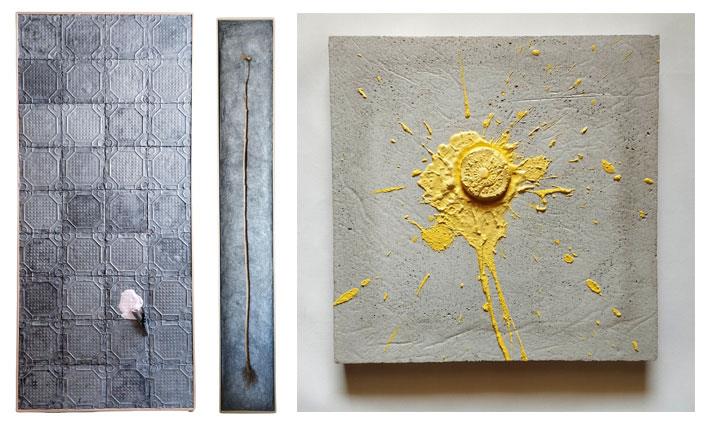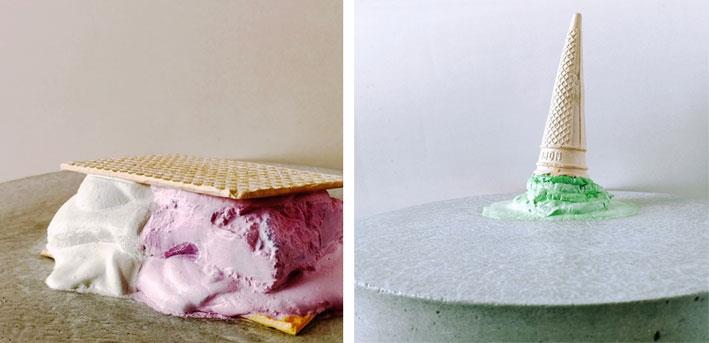We are all thrilled to finally be hosting Nathan Portelli's debut solo art exhibition at il-Kamra ta' Fuq, curated by yours truly. Id-Diżappunt will run until 13 April.
Let's start by getting to know our artist a little better. Nathan hails from Gozo, and every time he visits us in Mqabba, he brings an entourage of friends along with him. It's always fun and interesting to chat with him, and things got even more exciting when we managed to find a slot in our calendar and began planning his first solo exhibition.
Even the studio visit to Gozo was a lot of fun. We started with a visit to Nathan's favourite bar in Qala, followed by a stop at what is said to be the best bakery on the islands (it was closed... just my luck), and then headed to his studio in Nadur, where it became clear where his inspiration and love for Gozo's beautiful countryside come from.

A quick background check tells us that Portelli holds a degree in History of Art from the Department of Art and Art History at the University of Malta. His deep connection to his homeland and his concern for humanity's impact on it are the primary influences in his work.
Back to our exhibition - let's start with the title. This time around, I get zero credit for it; in fact, this witty title comes entirely from Portelli himself. Id-Diżappunt (The Disappointment) naturally triggers quizzical looks and thoughts, as it should. He is using cement as his primary medium, and this is very important symbolically and conceptually as, whether we like it or not, it has become an integral part of our built environment. I'd say Portelli is making quite an impact with his debut solo show.
The inspiration comes from the ongoing issue of overdevelopment, particularly in his native island of Gozo. Once an idyllic place, Gozo is undergoing drastic changes - both aesthetically and in terms of its identity. This transformation is deeply disappointing for Portelli, and he draws a comparison between this loss and a more naïve version of ourselves by reflecting on childhood memories - those little "tragedies" that, at a tender age, feel like the end of the world but later prove insignificant. Moments like when a long-awaited ice cream cone falls to the floor or a perfect ġbejna shatters.
Portelli presents a variety of ice cream flavours and types, all with one thing in common - they started melting or they've fallen to the floor (and I'm afraid the three-second rule doesn't apply here!). With his fantastic play on trompe l'oeil, the artist creates hyper-realistic sculptures of ice cream cones and ice cream sandwiches, all made from cement with an acrylic finish. It was a real struggle not to touch them while we were setting up - tomorrow, I'll go touch them alone - but you shouldn't!

Two massive artworks depict a typical cement flooring, the kind with deep indentations often found in public spaces like pavements and church parvises (perhaps mostly in Gozo?). The artist has recreated this texture in cement, almost like a fingerprint of an identity that is being lost. Each piece features a shattered ice cream cone resting on the tiles. The works, titled Il-Bankina u l-Ġelat I & II, not only capture the moment of losing an ice cream to the floor but also the embarrassment of doing so in front of all your friends - perhaps right outside on the pavement, after buying it from an ice cream van roaming the streets.
The scene becomes even more surreal when you realize that what looks like flooring is actually a wall-hanging sculpture. (Yes, there was ample swearing involved in getting them upstairs at il-Kamra ta' Fuq, but somehow, we always manage!)
Have you ever imagined fireworks as ġbejniet? Well, Nathan did - and he even managed to bring this vision to life with Kaxxa Infernali. Here, the sky transforms into a cemented wall or floor, and the fireworks - such an important part of our identity - become discarded, shattered ġbejniet. These cheeselets, in vibrant pops of colour and soft pastels, create a beautiful splash of ġbejna matter around them, mimicking the bursts of fireworks, one after the other, leaving behind ephemeral patterns of light in a dark sky.
Two more works featuring ġbejniet take the form of large cement roundels, each displaying half a dozen melted cheeselets. The roundels seem to evoke the pattern of another deeply traditional item, the ħasira, which serves as the backdrop for this melting goodness.

Every detail in Portelli's work carries meaning. He did, however, give us one piece where the beloved ġbejniet remained intact, ready to be enjoyed. Titled Tużżana Ġbejniet, the artwork presents a dish holding a perfect dozen cheeselets, squeezed together in a cozy arrangement. Portelli mentioned that the dish is modeled after one his mother uses weekly to purchase fresh cheeselets from their neighbour.
Another two works, which, although separate, are conceptually a diptych, are ġennaINFERN I & II. These pieces feature two very long and narrow compositions, each depicting a Lelluxa flower (Crown Daisy) against a cement backdrop. The word INFERN is intentionally capitalized in the title, emphasising how our lives are turning into a living hell within an ever-expanding concrete jungle.
These flowers are reminiscent of childhood, a time when we were surrounded by the countryside and wildflowers with yellowish petals. As children, we played the game Ġenna/Infern (Heaven or Hell), plucking petals one by one while alternating between "heaven" and "hell". The final petal determined our fate. Another version of this game, helps us "determine" if he/she Loves Me/Loves Me Not.
In these artworks, the flowers are presented in their full length, including their roots, with just one last petal remaining. They have been dried for over a year. The inclusion of the roots reinforces the metaphor of life itself: they symbolise our origins, our identity, and where we come from, leading up to the inevitable question - will we end up in heaven or in hell?
The cement background is riddled with cracks, representing the struggles and obstacles we face throughout life. Meanwhile, the long flower stem subtly hints at the journey we all undertake.
Perhaps one of the messages of this exhibition is that we are sometimes treated like children - expected to remain naive, numb and indifferent to everything happening around us. With a tongue-in-cheek approach, Portelli encourages us to reflect on how our priorities shift over time and to focus on what truly matters, especially for the future - before it's too late.
The exhibition runs at il-Kamra ta' Fuq until 13 April.
For more information visit the venue's social media pages